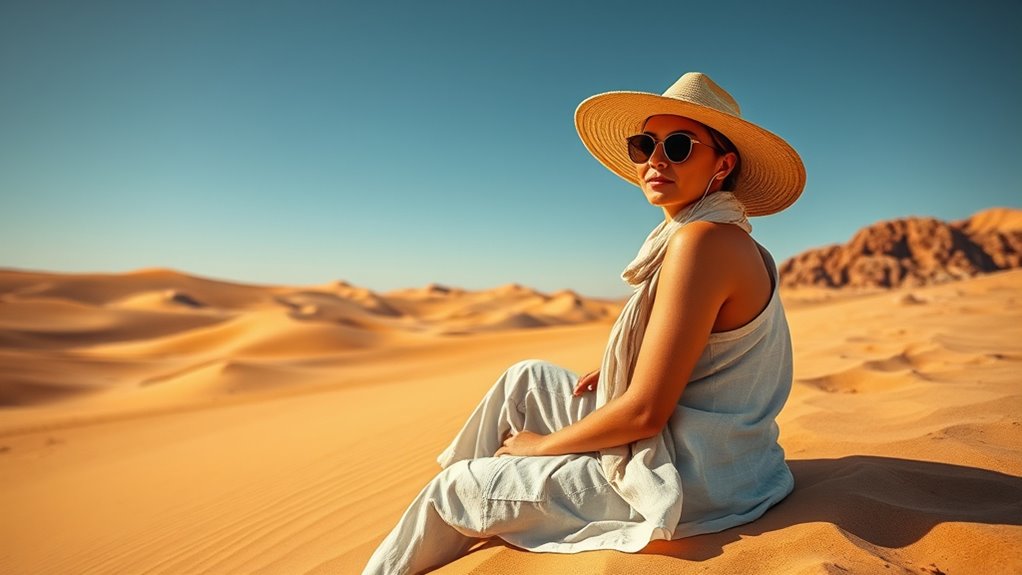When tanning in dry desert climates, protect your skin by applying broad-spectrum SPF sunscreen generously 15 minutes before sun exposure, and reapply every two hours. Wear protective clothing like wide-brimmed hats and long sleeves, seek shade often, and avoid peak sun hours. Stay well-hydrated with water and electrolyte drinks to prevent dehydration and keep your skin supple. Maintaining these habits helps prevent burns and long-term damage—keep exploring for more essential tips to stay safe and healthy.
Key Takeaways
- Apply broad-spectrum SPF sunscreen generously 15 minutes before sun exposure and reapply every two hours.
- Wear protective clothing like wide-brimmed hats and long-sleeved shirts to cover skin.
- Seek shade during peak hours (10 a.m. – 4 p.m.) and limit direct sun exposure duration.
- Stay hydrated with water and electrolyte drinks to prevent dehydration and skin dryness.
- Use nourishing lotions or aloe vera after sun exposure to soothe and maintain skin moisture.

Tanning in dry heat can be surprisingly different from doing so in humid conditions, requiring you to adapt your approach for safer and more effective results. In desert climates, the intense sun and arid air can quickly dehydrate your skin and increase the risk of sun damage. To enjoy a tan without harming your skin, you need to prioritize sun protection and hydration strategies that are tailored to these extreme conditions. Sunscreen is your first line of defense; choose a broad-spectrum SPF that shields against both UVA and UVB rays. Apply it generously at least 15 minutes before sun exposure and reapply every two hours, especially if you’re sweating or wiping your skin. Remember, the sun in dry climates can be more unforgiving because the lack of humidity means the sun’s rays penetrate more directly, increasing your risk of burns and long-term skin damage.
Hydration strategies are equally critical when tanning in dry heat. The arid air pulls moisture from your skin quickly, so you must drink plenty of water throughout the day. Carry a water bottle and sip regularly, even if you don’t feel thirsty. Proper hydration helps maintain your skin’s elasticity and prevents dryness and flakiness caused by sun exposure. Besides drinking water, consider incorporating electrolyte drinks to replace salts lost through sweat, especially if you’re spending extended periods outdoors. Moisturizing your skin before and after sun exposure also plays a crucial role. Use a nourishing lotion or aloe vera gel to soothe and replenish moisture, helping to prevent peeling and irritation. Incorporating skin protection measures such as wearing protective clothing can also significantly reduce UV exposure and skin damage.
You should also be mindful of the timing and duration of your sun sessions. Avoid peak hours when the sun is at its strongest—typically between 10 a.m. and 4 p.m.—to minimize the risk of burns. Instead, opt for early morning or late afternoon tanning, when the sun’s rays are less intense. Cover your skin with protective clothing, such as wide-brimmed hats and lightweight, long-sleeved shirts, to shield yourself from direct sunlight. Seek shade periodically to give your skin a break and reduce cumulative UV exposure. Remember, even on cloudy days, UV rays can penetrate and cause damage, so consistent sun protection remains essential. By combining vigilant sun protection with effective hydration strategies, you can enjoy your time in the desert while safeguarding your skin from the harsh effects of dry heat.
Frequently Asked Questions
How Does Dry Heat Affect Skin Hydration During Tanning?
Dry heat can markedly reduce your skin’s hydration during tanning, leading to dehydration effects like dryness, flakiness, and increased sensitivity. To counter this, you should focus on moisture retention strategies, such as applying hydrating lotions and drinking plenty of water. Staying protected from the sun with sunscreen also helps prevent further moisture loss. By maintaining proper hydration, you keep your skin healthy and better equipped to handle the dry heat.
Are There Specific Clothing Materials That Block UV in Deserts?
Think of UV blocking fabrics as your desert armor. You’ll want breathable clothing made from materials like tightly woven cotton, nylon, or specialized fabrics designed for UV protection. These fabrics act like a shield, blocking harmful rays while keeping you cool. Look for clothing labeled with UPF ratings, which indicate effective UV protection. Wearing these helps you enjoy the desert’s beauty without risking your skin’s health.
What Are the Signs of Early Skin Damage in Dry Heat?
You might notice early skin damage through skin discoloration, which often appears as dull, uneven patches. An itching sensation can also signal irritation or beginning damage from sun exposure. These signs happen when your skin starts to react to UV rays, so pay attention. If you see changes in skin tone or feel itchy, it’s time to protect your skin better by seeking shade, applying sunscreen, and wearing protective clothing.
Can Desert Tanning Accelerate Skin Aging?
You might wonder if desert tanning accelerates skin aging. The truth is, frequent UV exposure from intense desert sun increases aging signs like wrinkles, fine lines, and age spots. Tanning in dry heat exposes your skin to harmful rays that break down collagen and elastin, speeding up the aging process. So, while you’re soaking up the sun, you’re also boosting your risk of early skin aging.
How Often Should Sunscreen Be Reapplied in Desert Conditions?
You should reapply sunscreen every two hours to maintain effective desert sun protection. If you’re sweating or swimming, reapply more often, around every 40-80 minutes. Regular sunscreen reapplication is essential because the intense desert sun can quickly break down the protective barrier. Always choose a broad-spectrum sunscreen with high SPF, wear protective clothing, and seek shade when possible to minimize skin damage in dry heat conditions.
Conclusion
So, when you’re out in the desert heat, remember that your skin is more delicate than a fragile butterfly. Protect it fiercely with sunscreen, protective clothing, and plenty of hydration. Don’t let the blazing sun turn your skin into an unrecognizable, shriveled relic. You’ve got the power to keep your skin safe and glowing, no matter how scorching the surroundings. Stay vigilant, stay beautiful, and let your skin shine brighter than the desert sun itself!









